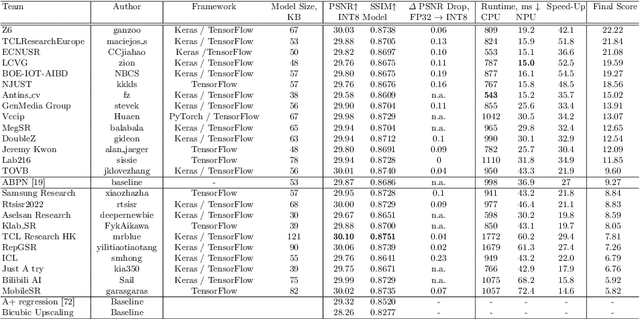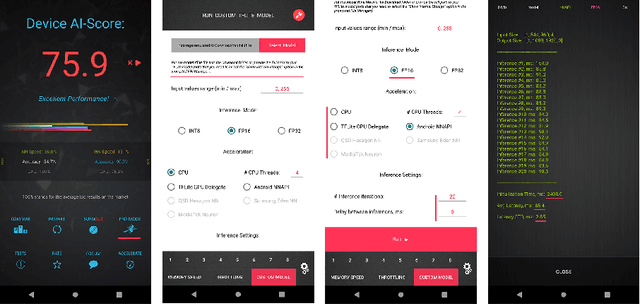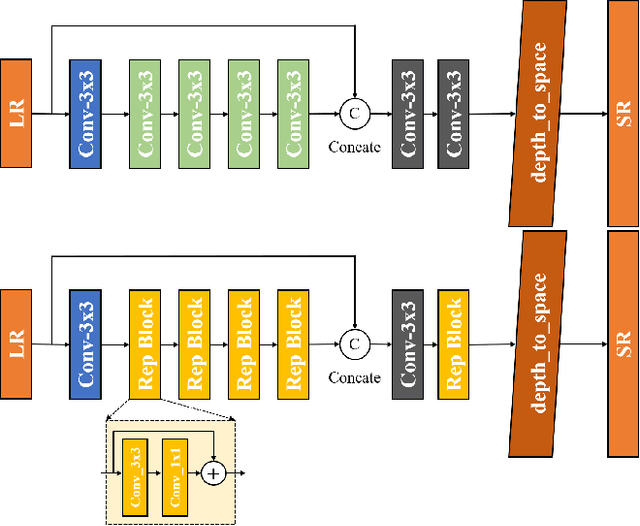Kasidis Arunruangsirilert
Real-time Video Prediction With Fast Video Interpolation Model and Prediction Training
Mar 29, 2025Abstract:Transmission latency significantly affects users' quality of experience in real-time interaction and actuation. As latency is principally inevitable, video prediction can be utilized to mitigate the latency and ultimately enable zero-latency transmission. However, most of the existing video prediction methods are computationally expensive and impractical for real-time applications. In this work, we therefore propose real-time video prediction towards the zero-latency interaction over networks, called IFRVP (Intermediate Feature Refinement Video Prediction). Firstly, we propose three training methods for video prediction that extend frame interpolation models, where we utilize a simple convolution-only frame interpolation network based on IFRNet. Secondly, we introduce ELAN-based residual blocks into the prediction models to improve both inference speed and accuracy. Our evaluations show that our proposed models perform efficiently and achieve the best trade-off between prediction accuracy and computational speed among the existing video prediction methods. A demonstration movie is also provided at http://bit.ly/IFRVPDemo.
Performance Analysis of 5G FR2 (mmWave) Downlink 256QAM on Commercial 5G Networks
Feb 05, 2025Abstract:The 5G New Radio (NR) standard introduces new frequency bands allocated in Frequency Range 2 (FR2) to support enhanced Mobile Broadband (eMBB) in congested environments and enables new use cases such as Ultra-Reliable Low Latency Communication (URLLC). The 3GPP introduced 256QAM support for FR2 frequency bands to further enhance downlink capacity. However, sustaining 256QAM on FR2 in practical environments is challenging due to strong path loss and susceptibility to distortion. While 256QAM can improve theoretical throughput by 33%, compared to 64QAM, and is widely adopted in FR1, its real-world impact when utilized in FR2 is questionable, given the significant path loss and distortions experienced in the FR2 range. Additionally, using higher modulation correlates to higher BLER, increased instability, and retransmission. Moreover, 256QAM also utilizes a different MCS table defining the modulation and code rate at different Channel Quality Indexes (CQI), affecting the UE's link adaptation behavior. This paper investigates the real-world performance of 256QAM utilization on FR2 bands in two countries, across three RAN manufacturers, and in both NSA (EN-DC) and SA (NR-DC) configurations, under various scenarios, including open-air plazas, city centers, footbridges, train station platforms, and stationary environments. The results show that 256QAM provides a reasonable throughput gain when stationary but marginal improvements when there is UE mobility while increasing the probability of NACK responses, increasing BLER, and the number of retransmissions. Finally, MATLAB simulations are run to validate the findings as well as explore the effect of the recently introduced 1024QAM on FR2.
Practical Commercial 5G Standalone (SA) Uplink Throughput Prediction
Jul 23, 2023



Abstract:While the 5G New Radio (NR) network promises a huge uplift of the uplink throughput, the improvement can only be seen when the User Equipment (UE) is connected to the high-frequency millimeter wave (mmWave) band. With the rise of uplink-intensive smartphone applications such as the real-time transmission of UHD 4K/8K videos, and Virtual Reality (VR)/Augmented Reality (AR) contents, uplink throughput prediction plays a huge role in maximizing the users' quality of experience (QoE). In this paper, we propose using a ConvLSTM-based neural network to predict the future uplink throughput based on past uplink throughput and RF parameters. The network is trained using the data from real-world drive tests on commercial 5G SA networks while riding commuter trains, which accounted for various frequency bands, handover, and blind spots. To make sure our model can be practically implemented, we then limited our model to only use the information available via Android API, then evaluate our model using the data from both commuter trains and other methods of transportation. The results show that our model reaches an average prediction accuracy of 98.9\% with an average RMSE of 1.80 Mbps across all unseen evaluation scenarios.
Pensieve 5G: Implementation of RL-based ABR Algorithm for UHD 4K/8K Content Delivery on Commercial 5G SA/NR-DC Network
Dec 29, 2022Abstract:While the rollout of the fifth-generation mobile network (5G) is underway across the globe with the intention to deliver 4K/8K UHD videos, Augmented Reality (AR), and Virtual Reality (VR) content to the mass amounts of users, the coverage and throughput are still one of the most significant issues, especially in the rural areas, where only 5G in the low-frequency band are being deployed. This called for a high-performance adaptive bitrate (ABR) algorithm that can maximize the user quality of experience given 5G network characteristics and data rate of UHD contents. Recently, many of the newly proposed ABR techniques were machine-learning based. Among that, Pensieve is one of the state-of-the-art techniques, which utilized reinforcement-learning to generate an ABR algorithm based on observation of past decision performance. By incorporating the context of the 5G network and UHD content, Pensieve has been optimized into Pensieve 5G. New QoE metrics that more accurately represent the QoE of UHD video streaming on the different types of devices were proposed and used to evaluate Pensieve 5G against other ABR techniques including the original Pensieve. The results from the simulation based on the real 5G Standalone (SA) network throughput shows that Pensieve 5G outperforms both conventional algorithms and Pensieve with the average QoE improvement of 8.8% and 14.2%, respectively. Additionally, Pensieve 5G also performed well on the commercial 5G NR-NR Dual Connectivity (NR-DC) Network, despite the training being done solely using the data from the 5G Standalone (SA) network.
Efficient and Accurate Quantized Image Super-Resolution on Mobile NPUs, Mobile AI & AIM 2022 challenge: Report
Nov 07, 2022



Abstract:Image super-resolution is a common task on mobile and IoT devices, where one often needs to upscale and enhance low-resolution images and video frames. While numerous solutions have been proposed for this problem in the past, they are usually not compatible with low-power mobile NPUs having many computational and memory constraints. In this Mobile AI challenge, we address this problem and propose the participants to design an efficient quantized image super-resolution solution that can demonstrate a real-time performance on mobile NPUs. The participants were provided with the DIV2K dataset and trained INT8 models to do a high-quality 3X image upscaling. The runtime of all models was evaluated on the Synaptics VS680 Smart Home board with a dedicated edge NPU capable of accelerating quantized neural networks. All proposed solutions are fully compatible with the above NPU, demonstrating an up to 60 FPS rate when reconstructing Full HD resolution images. A detailed description of all models developed in the challenge is provided in this paper.
 Add to Chrome
Add to Chrome Add to Firefox
Add to Firefox Add to Edge
Add to Edge